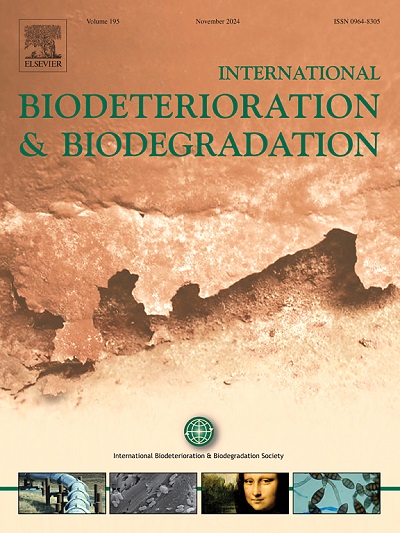Fermentation of highly toxic reed hydrolysate using Candida glycerinogenes to produce platform compound glycerol
IF 4.1
2区 环境科学与生态学
Q2 BIOTECHNOLOGY & APPLIED MICROBIOLOGY
International Biodeterioration & Biodegradation
Pub Date : 2025-03-26
DOI:10.1016/j.ibiod.2025.106069
引用次数: 0
Abstract
Reed, wild plants all over the world, remains underutilized as a fermentation feedstock due to the high inhibitory of its hydrolysate. Most studies on lignocellulose fermentation have focused on ethanol production; however, glycerol, as a platform compound, holds broader application prospects due to its versatility in producing various metabolites. This study aims to enhancing the resistance of Candida glycerinogenes through genetic modifications to improve its resistance to inhibitors. Our results demonstrate that the gene CgLYRM6 demonstrated effective detoxification against a range of aldehyde inhibitors, including furfural, vanillin, benzaldehyde, 2,5-dimethylbenzaldehyde, and 3,4-dimethylbenzaldehyde.The final engineered strain Cg1 carrying LYRM6, TAL1 and UGA2 achieved a glycerol titer of 31 g/L in reed hydrolysate, a 24 % increase compared to the wild type. And glycerol titer reached 40 g/L in the 5 L bioreactor, showing an 60 %increase in production. The strain had shorter fermentation cycle and stronger detoxification ability compared to the control strain. This route enabled simultaneous fermentation and detoxification, providing intermediate metabolites for further conversion and offering a new strategy to utilize undetoxified, alkali-pretreated reed hydrolysate for the production of various metabolites.

用产甘油假丝酵母发酵剧毒芦苇水解液生产平台复合甘油
芦苇是一种遍布世界各地的野生植物,由于其水解产物的高抑制作用,作为发酵原料的利用不足。大多数关于木质纤维素发酵的研究都集中在乙醇生产上;而甘油作为平台化合物,可产生多种代谢物,具有广泛的应用前景。本研究旨在通过基因修饰提高产甘油假丝酵母对抑制剂的抗性。我们的研究结果表明,CgLYRM6基因对一系列醛抑制剂,包括糠醛、香兰素、苯甲醛、2,5-二甲基苯甲醛和3,4-二甲基苯甲醛具有有效的解毒作用。携带LYRM6、TAL1和UGA2的最终工程菌株Cg1在芦苇水解物中的甘油滴度为31 g/L,与野生型相比提高了24%。在5l的生物反应器中甘油滴度达到40 g/L,产量提高60%。与对照菌株相比,该菌株发酵周期短,解毒能力强。这条路线使发酵和解毒同时进行,为进一步转化提供了中间代谢物,并提供了一种利用未解毒、碱预处理的芦苇水解液生产各种代谢物的新策略。
本文章由计算机程序翻译,如有差异,请以英文原文为准。
求助全文
约1分钟内获得全文
求助全文
来源期刊
CiteScore
9.60
自引率
10.40%
发文量
107
审稿时长
21 days
期刊介绍:
International Biodeterioration and Biodegradation publishes original research papers and reviews on the biological causes of deterioration or degradation.

 求助内容:
求助内容: 应助结果提醒方式:
应助结果提醒方式:


